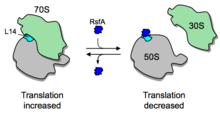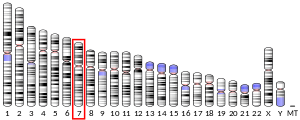MALSU1
MALSU1 is a gene on chromosome 7 in humans that encodes the protein MALSU1.[5] This protein localizes to mitochondria and is probably involved in mitochondrial translation or the biogenesis of the large subunit of the mitochondrial ribosome.
| MALSU1 | |||||||||||||||||||||||||
|---|---|---|---|---|---|---|---|---|---|---|---|---|---|---|---|---|---|---|---|---|---|---|---|---|---|
| Identifiers | |||||||||||||||||||||||||
| Aliases | MALSU1, C7orf30, mtRsfA, mitochondrial assembly of ribosomal large subunit 1 | ||||||||||||||||||||||||
| External IDs | OMIM: 614624 MGI: 1922843 HomoloGene: 16317 GeneCards: MALSU1 | ||||||||||||||||||||||||
| |||||||||||||||||||||||||
| |||||||||||||||||||||||||
| |||||||||||||||||||||||||
| Orthologs | |||||||||||||||||||||||||
| Species | Human | Mouse | |||||||||||||||||||||||
| Entrez | |||||||||||||||||||||||||
| Ensembl | |||||||||||||||||||||||||
| UniProt | |||||||||||||||||||||||||
| RefSeq (mRNA) | |||||||||||||||||||||||||
| RefSeq (protein) | |||||||||||||||||||||||||
| Location (UCSC) | Chr 7: 23.3 – 23.31 Mb | Chr 6: 49.07 – 49.09 Mb | |||||||||||||||||||||||
| PubMed search | [3] | [4] | |||||||||||||||||||||||
| Wikidata | |||||||||||||||||||||||||
| |||||||||||||||||||||||||
Protein
MALSU1 is a member of the DUF143[6] family (= domain of unknown function 143, Pfam PF02410) which is highly conserved in both prokaryotes and eukaryotes but not archaea.[7] Examples of mammalian conservation are given below using the ALIGN tool from the San Diego Supercomputer Center Biology Workbench.[8] Percentages indicate the identity shared by the human protein and the respective mammalian protein. Accession numbers are from the NCBI database.
| Species | Accession # | Identity |
|---|---|---|
| Macaca mulatta | XP_001098609 | 93.20% |
| Sus scrofa | NP_001092054 | 85.50% |
| Bos taurus | NP_001068866 | 88.50% |
| Canis familiaris | XP_853850 | 77.30% |
| Rattus norvegicus | NP_001100063 | 81.60% |
| Equus caballus | XP_001497879 | 90.70% |
There are no known or predicted paralogs in Homo sapiens. That is, MALSU1 is a single-copy gene.
The domain is from position 93 to 194 on the human protein and comprises 43.2% of the sequence. This conserved domain is also present in the plant gene iojap, a pattern-striping gene in maize.[9][10] However, since its function has been solved at least in bacteria, it is no longer a "domain of unknown function".
Protein function

While the function of the protein in mitochondria is not conclusive[11][12] its bacterial homolog has been shown to silence prokaryotic translation by blocking the two ribosomal subunits from joining, hence it was called RsfS (= ribosomal silencing factor in starvation or stationary phase, a synonym of RsfA[13]).
Protein-protein interactions. RsfS has been shown via a yeast two-hybrid screen to interact with ribosomal protein L14 in four bacterial species as well as in mitochondria.[13] MALSU1 was shown to interact with CHMP protein[14] which is part of the ESCRT-III complex (Endosomal Sorting Complex Required for Transport). DUF143 has also been shown to interact with UFD1, tRNA synthetases class II, and Cytidylyltransferase in various architectures.[15]
Properties
Bioinformatics predicted the following properties for LOC_115416:
- Molecular Weight: 26.2 KDal
- Isoelectric Point: 5.155
Gene
C7ORF30 is located on chromosome 7 in humans and runs from 23,305,465 to 23,315,705.[16] There are four predicted exons in the human gene with conservation occurring across most mammalian species. There is no conclusive data regarding whether the gene is ubiquitously expressed in human tissues, but expressed sequence tag databases show that it is expressed in many tissues.[17]
Neighboring Genes
MALSU1 is neighbored by GPNMB upstream and IGF2BP3 downstream, however the latter gene is transcribed on the opposite strand running from the 3' to the 5' end. There is some slight overlap of the untranslated regions of C7ORF30 and IGF2BP3 whereas the distance between C7ORF30 and GPNMB is 24,211 base pairs.
References
- GRCh38: Ensembl release 89: ENSG00000156928 - Ensembl, May 2017
- GRCm38: Ensembl release 89: ENSMUSG00000029815 - Ensembl, May 2017
- "Human PubMed Reference:". National Center for Biotechnology Information, U.S. National Library of Medicine.
- "Mouse PubMed Reference:". National Center for Biotechnology Information, U.S. National Library of Medicine.
- "Entrez Protein: LOC_115416".
- "DUF 143".
- "Pre-computed BLAST results for LOC115416 [Homo sapiens]". BLINK ("BLAST Link"). National Center for Biotechnology Information, United States National Institutes of Health.
- "SDSC Biology Workbench".
- "InterPro: IPR004394 Iojap-related protein".
- Marchler-Bauer A, Anderson JB, Derbyshire MK, DeWeese-Scott C, Gonzales NR, Gwadz M, Hao L, He S, Hurwitz DI, Jackson JD, Ke Z, Krylov D, Lanczycki CJ, Liebert CA, Liu C, Lu F, Lu S, Marchler GH, Mullokandov M, Song JS, Thanki N, Yamashita RA, Yin JJ, Zhang D, Bryant SH (November 2006). "CDD: a conserved domain database for interactive domain family analysis". Nucleic Acid Residues. 35 (D237-40): D237–40. doi:10.1093/nar/gkl951. PMC 1751546. PMID 17135202.
- "MitoProt II - v1.101". MitoProt II - v1.101 prediction. Institut für Humangenetik, Technische Universität, München.
- Claros MG, Vincens P (November 1996). "Computational method to predict mitochondrially imported proteins and their targeting sequences". European Journal of Biochemistry / FEBS. 241 (3): 779–86. doi:10.1111/j.1432-1033.1996.00779.x. PMID 8944766.
- Häuser, R.; Pech, M.; Kijek, J.; Yamamoto, H.; Titz, B. R.; Naeve, F.; Tovchigrechko, A.; Yamamoto, K.; Szaflarski, W.; Takeuchi, N.; Stellberger, T.; Diefenbacher, M. E.; Nierhaus, K. H.; Uetz, P. (2012). Hughes, Diarmaid (ed.). "RsfA (YbeB) Proteins Are Conserved Ribosomal Silencing Factors". PLoS Genetics. 8 (7): e1002815. doi:10.1371/journal.pgen.1002815. PMC 3400551. PMID 22829778.
- Tsang HT, Connell JW, Brown SE, Thompson A, Reid E, Sanderson CM (September 2006). "A systematic analysis of human CHMP protein interactions: additional MIT domain-containing proteins bind to multiple components of the human ESCRT III complex". Genomics. 88 (3): 333–46. doi:10.1016/j.ygeno.2006.04.003. PMID 16730941.
- "Sanger Institute Domain Organization PF02410".
- "UCSD Genome Browser".
- "NCBI Unigene Expression Data".
External links
- Human MALSU1 genome location and MALSU1 gene details page in the UCSC Genome Browser.



